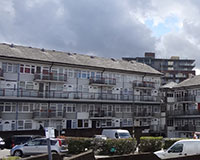 The current political groupthink about council housing estates in London is “knock them down and rebuild at double the density”. Depending on your political persuasion, this is to protect the green belt or use high land values to rehouse low-income households.
The current political groupthink about council housing estates in London is “knock them down and rebuild at double the density”. Depending on your political persuasion, this is to protect the green belt or use high land values to rehouse low-income households.
In a widely criticised report by the Institute for Public Policy Research, Labour peer Andrew Adonis wrote: “By systematically mobilising their vast ownership of land already designated and used for housing, local authorities could pioneer the creation of many hundreds of new city villages London-wide.”
Likewise, Number 10 housing adviser Alex Morton wrote: “Demolishing high-rise social housing blocks and replacing them with real streets made up of low-rise flats and terraced housing would improve the lives of thousands of people who suffer from living in multi-storey housing.”
This groupthink imagines these estates are in a single ownership – the local authority’s – and that redevelopment can replace all the subsidised housing, using market housing to pay for it.
This is wrong on every count.
Around a third of estate homes have been sold off on long leases, so redevelopment is going to be tricky, expensive and lengthy. Despite political disasters such as the Heygate Estate, SE1, politicians seem to have missed this fundamental truth.
The reality for delivery and viability of comprehensive estate redevelopment can be summarised in five points: First, it is expensive. Mainly because of leaseholders with long leases whose number is growing fast through Right to Buy. It is about to become almost impossibly expensive in inner London, as government forces councils to sell off their high-value flats. Expensive and time-consuming compulsory purchase is inevitably required.
Second, the environmental and social costs are huge. Communities are scattered and destroyed. The embodied carbon in the original building is released during demolition and the saving through greener new buildings is insufficient to offset it over the lifecycle of the scheme.
Third, demolition is unnecessary. With proper maintenance, as estates such as Barbican or parts of Thamesmead show, estates can be maintained and renewed and modern standards of insulation can be retrofitted.
Fourth, redevelopment is theoretically viable only on low-density estates in high-value areas. Elsewhere the like-for-like replacement cannot be funded by cross subsidy from the land value generated from market housing without a significant grant. Most initial appraisals are wildly optimistic and dependent on there being no property market cycles.
In central London, developers would be lucky if one home for sale could pay for the replacement of one rented home. In outer areas, density would have to be increased by six to 10 times to make regeneration viable.
Finally, there are no clever funding solutions. Exotic private sector funding models are mostly snake oil. Local authority borrowing is the cheapest and other options appear attractive only because of artificial government-imposed restrictions on local authority borrowing.
The alternative to redevelopment is a combination of repair and maintenance and infill development. Infill is much faster as it does not require CPOs and it can release the underlying land value to help fund the backlog of repairs.
But it is not without its challenges and an entirely new approach, which puts the current community in charge, is often the best way of getting local support. Local homes, by local people, for local people.
In Bermondsey, tenant management organisation Leathermarket JMB, supported by Southwark council and the GLA, has set up a community benefit society that is delivering new homes with the support of local people.
There are also many easier places to start increasing housing supply in London. Savills, a big advocate of comprehensive estate redevelopment, is currently investigating options for the London Land Commission. New London Architecture is running an exhibition of 100 new ideas to increase housing delivery.
Many of London’s housing zones are not related to council housing estates. The airspace above redundant car parks, obsolescent retail parks with expiring leases in single ownership and some of London’s low-rise industrial estates, such as those around Old Oak Common, have potential.
It is time for rational analysis to replace groupthink.
Chris Brown is chief executive of Igloo Regeneration










